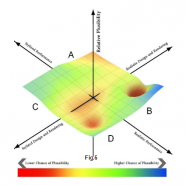 TAG Profiles is a blog series that explores the work of current TAG scholars. Seyed M Tabatabaei is a second year Master of Design (MDes) at Concordia University who studies virtual reality.
TAG Profiles is a blog series that explores the work of current TAG scholars. Seyed M Tabatabaei is a second year Master of Design (MDes) at Concordia University who studies virtual reality.
Seyed, the primary focus of your research is virtual reality, but I understand that you have experience in both architecture and animation?
Yes, I actually earned a bachelor degree in architecture and worked as a professional architect before getting into the animation industry. My father has background in both theatre and documentary film-making, so I’ve always had a passion towards animation and multimedia.
In architecture, I used to do a lot of 3D visualization – lighting and computer graphics stuff – but I didn’t really know anything about animating. I started to get involved in animation after I was admitted to an MFA in animation at Tehran University of Arts – which was a turning point in my life. Getting into the program was a very brilliant occasion to start learning many things about the field: the basics of animation; various styles of animation from experimental to mainstream; principles of Disney animation; and software like 3DS Max, Maya, and After Effects. It was like a revolution for me!
You went from spatial design, to animation, to virtual reality. What made you want to move in that direction?
I was always interested in the interactive art. I remember that like, maybe 20 years back, I started learning some basic codes in Flash. It was challenging – and still is challenging – because scripting and coding is not always something that comes easily to artists. It’s more logical and rational… it’s another mindset.
Artists – if they can use them efficiently – can use these tools to bring interactivity to their work. This is what I’m doing now, by learning to code in Unity. Unity is really new to me, but game engines are something that I am passionate to learn in order to bring interactivity to animation.
Architecture is all about spatial thinking, animation is all about temporal thinking. Virtual reality is a good platform to combine these two… to mix them. Virtual reality is about making another world, you could say, so it includes everything. It carries all of the experiences I have with it.
What are the avenues that you are currently exploring through your research?
There are three things that I am exploring right now.
First, are the technical challenges inherent to virtual reality – this includes the coding and practical considerations that I mentioned above.
Second, from a scientific point of view, I’m interested in the notion of scale in virtual reality. Specifically, how the perception of scale in virtual reality could be utilized as a communication device. What I noticed from experiencing different VR content is that scale is really something special. It is not something we’re used to experiencing in a flat screen medium or accustomed to feeling in an exaggerated way in architecture. So, here is my question: “how can scale be utilized as something specific to virtual reality?”
Finally, I have the challenge of content. After all, this project that I’m about to finalize will require some sort of content! What I’m trying to do – I’m exploring Iranian cultural traditions – is to give a different taste to this VR experience. To use all of my scientific questions to leverage this cultural content.
I’d like to get back to your MFA for a moment, as you have a couple of interesting outcomes from the degree: a paper and an animation. Let’s start with the paper.
 The question for this paper, Plausibility of 3D Characters: Towards a 2nd Uncanny Valley, really was: “I’m about to make a 3D animation – what are the criteria, what are the elements that contribute to the realism and plausibility of animation in general?” Specifically, I noticed that photorealism does not necessarily lead to the plausibility of a 3D animation. We have seen many things that are photorealistic but they are not necessarily appealing and plausible on many levels. That was my main question.
The question for this paper, Plausibility of 3D Characters: Towards a 2nd Uncanny Valley, really was: “I’m about to make a 3D animation – what are the criteria, what are the elements that contribute to the realism and plausibility of animation in general?” Specifically, I noticed that photorealism does not necessarily lead to the plausibility of a 3D animation. We have seen many things that are photorealistic but they are not necessarily appealing and plausible on many levels. That was my main question.
The second question was: “what is the role of a 3D character in contribution to the plausibility of a 3D animation?” After much research, I ended up dividing 3D characters into static components and kinetic components. I drew a diagram in which these ideas were illustrated and, based on that, I started to categorize a variety of 3D characters using that diagram in order study which areas are more critical in terms of plausibility.
I eventually reached a point where I am like: “there are two uncanny valleys in this diagram!” I kinda found another uncanny valley other than the famous one: one that is derived from the lack of performance – good performance – of 3D characters. When we are talking about uncanny, most of the time we discuss photorealism. But in that diagram, it is not necessarily about photorealism. It is about performance.
And alongside your research, you created a short animated film?
Yes! My 3D animation, Light Sight, is all about a single character in a room who is struggling to escape. My animation started from a class assignment – our professor asked us to make a short self-portrait kind of thing with any technique we were familiar with. Since I was familiar with 3D graphics and applications, I decided to go for a 3D animation technique. My teachers really encouraged me, so I continued working on it and eventually made it my final project.
I was a bit surprised at how well the animation is has been doing since then. Light Sight has been played in almost three hundred festivals around the world, and is now in the semi-finals round of the 45th Student Academy Awards!
